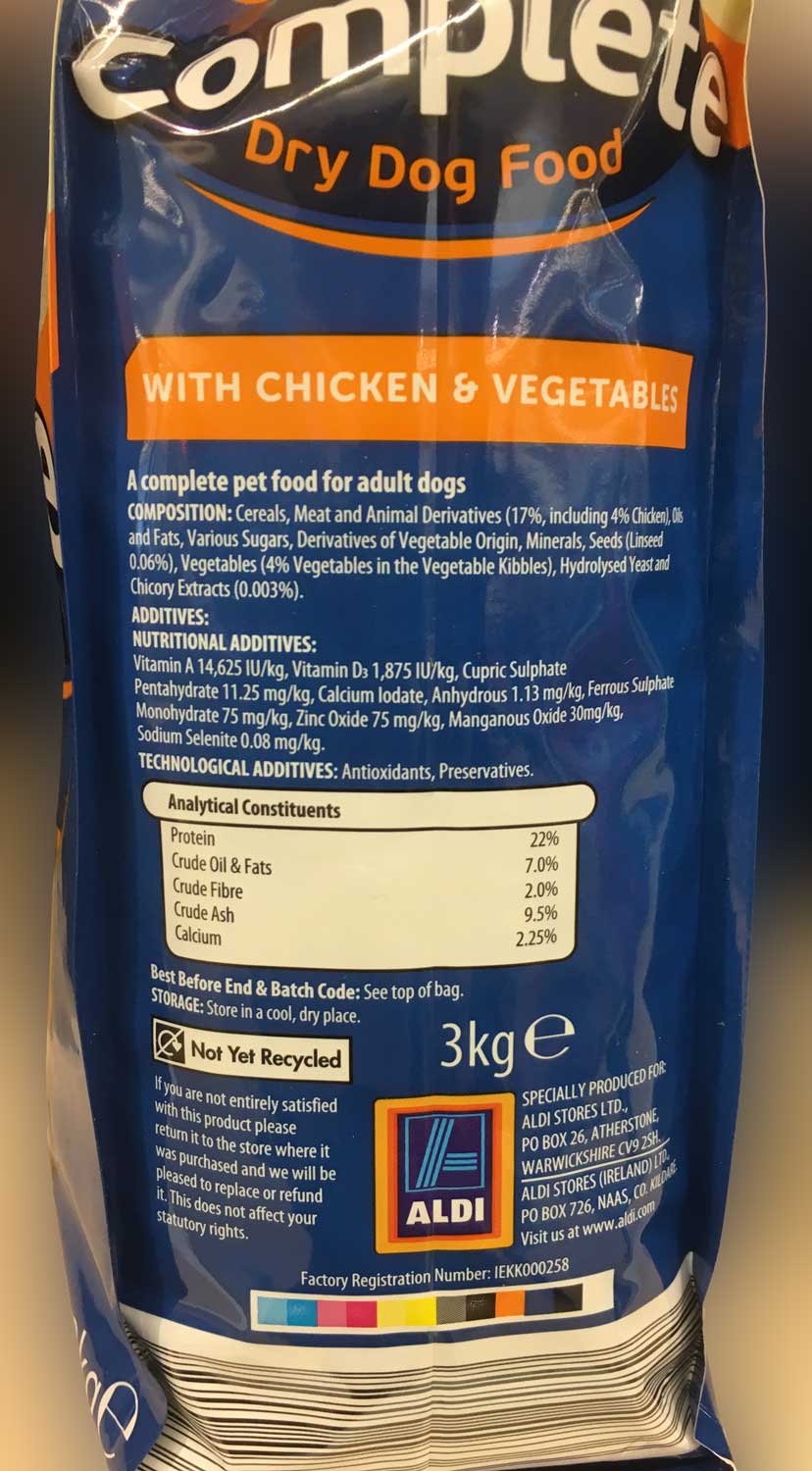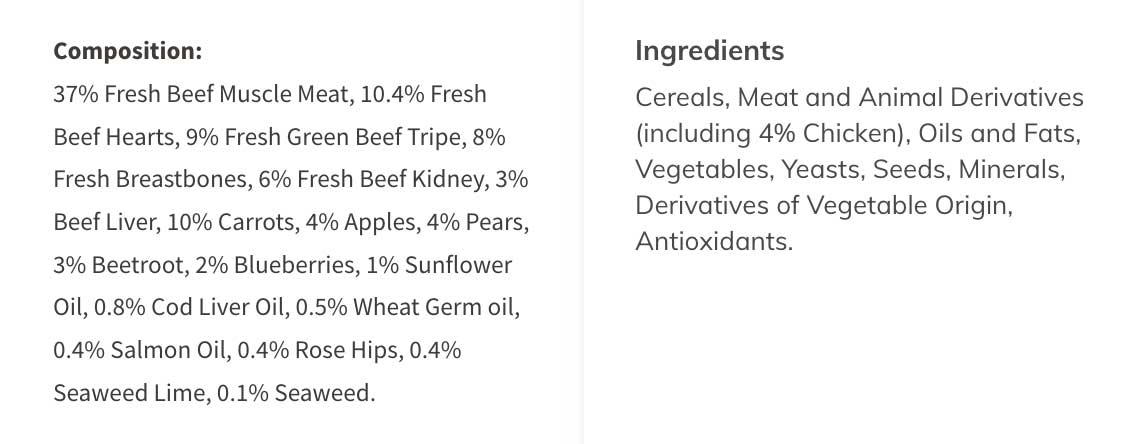Understanding Pet Food Labels: The Top 5 Pet Food Labelling Tricks to Look Out For
July 14, 2021 | By David Jackson, AllAboutDogFood.co.uk

Let's face it, choosing the best food for your best friend can be a real nightmare. Every single pet food producer wants you to believe that their foods are the best thing since sliced bread and they spend lots of time and money working out the best ways to get that message across. The trouble is, of course, most foods simply aren't very good so producers have to get creative with their labelling in order to convince you otherwise.
In this article we'll be looking at the top five strategies employed by pet food manufacturers to make their ingredients lists appear better than they really are as well as tips on how to spot them and how to assess the real quality of the dog food behind the smoke and mirrors.

Ignore the noise
Whenever take a look at a pack of dog food or visit a manufacturer's website, you are usually bombarded with enough health claims, buzzwords and slogans to make even the most seasoned pet owner's head spin. Everything on the packaging is specifically designed to draw you in and give you that warm fuzzy feeling, but it's essential to realise that most of it is just noise that can and should be ignored.
The fact is that outside of the statutory statement (the part of the label that includes the ingredient list and a few other key facts about the food), there is very little regulation or control over what manufacturers can and cannot say. For this reason, the industry collectively spends a huge amount of resources on constantly updating their branding and messaging to tap into whatever key words, phrases, colours and images they find are most likely to catch your attention ahead of the competition.
Some manufacturers also like to push the legal boundaries and experiment with downright misleading claims. They do this because the rewards of successfully pulling the wool over the public's eyes, even for a short time, are enormous while the risks are generally tiny. Firstly, there is no active monitoring of pet food marketing so unless someone makes a complaint, even the most flagrant violations of advertising standards are very unlikely to be picked up. Secondly, even when a piece of marketing is investigated and found to be illegal, most of the time Trading Standards will simply order the company to remove the claim from future publications... and that's it. No fine. No public retraction. No apology.
So, unfortunately, the only way to be sure you're not getting hoodwinked by clever pet food marketing is to ignore almost everything.

A textbook statutory statment including composition, additives, analytical constituents, best before date, batch number and company contact details.
What NOT to ignore
The statutory statement
The statutory statement is the one part of the packaging that is relatively closely controlled. It's where you'll find key product information including the ingredient list (sometimes called composition), the typical analysis (sometimes called analytical constituents), a list of nutritional additives, the best before date and the name and address of the manufacturer.
There are fairly strict rules over what must be included in the statutory statement and what must not. The format and even the wording of the statutory statment are stipulated in law which makes it your one source for reliable information on the product.
The ingredient list (aka composition)
And the most important part of the statutory statement is, of course, the ingredient list. It should always be your first (and often last) port of call when assessing a food. With even a little knowhow, a quick glance at the ingredient list will tell you whether the food is worth further consideration or whether it should be left well alone. You can find a quick summary of what to look for in a dog food ingredient list here.
Tricks of the trade
The trouble is, pet food manufacturers are also well aware of what consumers are looking for and they have found a whole host of ways to make otherwise unappealing ingredient lists appear more attractive to the unsuspecting eye.
Trick 1: Unclear ingredients
I know we're like a broken record here, but ingredient list clarity really is essential as without it, you could be feeding your dog just about anything.
By using ambiguous 'umbrella terms' like meat and animal derivatives, cereals, derivatives of vegetable origin etc, a manufacturer is absolutely free to use whatever terrible ingredients they have lying around and can make dramatic alterations to the recipe between batches with zero notice to their customers.
Less obvious terms like oils and fats, vegetables or even just meat are certainly less worrisome but still give the manufacturer far too much wiggle room and can make it hard for customers to know what's really in the food.
For these reasons it's important to always look for clear, unambiguous, individually listed ingredients. Meat and fish ingredients should always have their species source named.
Percentages also allow you to tell how much of an ingredient there is in the food and allow the manufacturer even less capacity to change things up between batches so the more percentages that are specified, the better.

Take a look at these two ingredient lists taken directly from the manufacturers' websites. On the left you have crystal clear transparency with each ingredient individually named and its percentage stated. Conversely, the ingredient list on the right tells us next to nothing about what is in the food.
Tricks 2 & 3: Ingredient splitting & ingredient grouping
By law, pet food ingredients need to be listed in descending order of their percentage at the so-called 'mixing bowl' stage - that is when all of the ingredients are put together ready for the final manufacturing process. This is why it's always a good idea to look for a food with meat as the first (and therefore most abundant) ingredient. Unfortunately, by cleverly grouping together or splitting up certain ingredients, manufacturers have found a way to rearrange the order of ingredients which can catch a lot of pet owners off guard.
Let's take a look at the following, fairly typical 'premium' dry dog food:
Example Dog Food Ingredient list:
Trout & Salmon 50% (22% Fresh Trout, 10% Salmon Meal, 10% Fresh Salmon, 4% Salmon Oil, 4% Salmon Stock), Sweet potato 12%, Potato 12%, Peas 11%, Potato flour 8%, Beet Pulp 4%, Pea protein 3%, Minerals & Vitamins.
Looks great right? Ingredients are clear and individually listed? Check! First ingredient is meat? Check! 50% meat is excellent and sweet potato is a decent carb source. What's not to like?
Well, it may surprise you that if you were to buy the above food, what your dog would actually eat would be quite different:
The same food but what your dog would actually eat:
Potato 27%, Sweet Potato 16%, Peas 15%, Salmon Meal 14.5%, Fresh Trout 8.5%, Beet Pulp 5.5%, Salmon Oil 5%, Pea protein 4%, Fresh Salmon 4%, <1% Salmon Stock, Minerals & Vitamins.
This is an excellent example of tactical splitting and grouping of ingredients in order to make a run-of-the-mill food much more appealing to the untrained eye.
Ingredient splitting
By separating less appealing ingredients into two or more sub entries, producers can push them down the ingredient list and make them appear a lot less significant. This is called ingredient splitting and it is most commonly done with grains and legumes like peas and lentils.
In the above example, the manufacturer has split both the potato and pea ingredients, each into two separate listings (potato & potato flour and peas & pea protein). Without splitting, both potato and peas would be much higher on the list.
Ingredient grouping
The opposite of splitting ingredients to move them down the list is grouping similar ingredients together, usually within a bracket, so that the total percentage is large enough to move them up. Manufacturers love doing this with their meat ingredients and sometimes rope in other animal derived ingredients like oils and even stock (read: water) to make their 'meat' content appear as high as possible.
Again looking at the example above, you can see that the manufacturer has grouped all of the fish ingredients together including the fish oil and fish broth, to make them the first ingredient and provide the highly desirable '50% fish' headline. Listed individually, though, the fish content would be much less significant.
Trick 4: Fresh meat and stock in dry dog foods
To be fair, there are plenty of good reasons for using fresh meat in dog food - not least it's nutritional quality, but it also makes it easy for manufacturers to claim far higher meat percentages than their foods actually contain.
As we mentioned above, ingredients have to be listed in order of their percentages before final processing. This includes both 'fresh' ingredients (that still contain large amounts of water) and dry ingredients (typically powders that have very low moisture levels).
As you might expect, when the ingredients are processed to make the final biscuit, almost all of the moisture from the fresh ingredients is lost making their proportion in the food shrink considerably.

In the example above, the food lists 22% fresh trout and 10% fresh salmon - a total of 32% fresh fish. But fresh fish contains roughly three quarters water and once most of it has been cooked away during processing, the proportion will be more like 13% in the finished biscuit. The 'salmon stock', which is almost entirely water, is reduced to nearly 0% in the finished product. This means that the total fish ingredient percentage in the biscuit is more like 27% - roughly half of the 50% advertised.
Trick 5: Dry ingredients in wet dog foods
In a similar way, wet food producers can make an ingredient look less significant than it is by simply adding it in a dry (usually powdered) form. That way, the percentage being added and declared on the ingredient list is fairly low but once it has been reconstituted with added water, it's proportion in the final food can increase by up to four or even five times. To illustrate, if you made a wet food with 50% fresh chicken, 10% wheat flour and 40% water, the wheat flour would absorb all of the water and the final ingredient composition would be more like 50% meat, 50% wheat.

Seeing through the smoke and mirrors
Put all of these tricks together and you can be left with an ingredient list with very little resemblance to the food's true composition. Fortunately, though, many of the telltale signs of ingredient list tampering are easy to spot so the next time you're comparing dog foods, be sure to look out for:
- Ambiguos terminology
- Numerous very similar grain or legume (peas, beans, lentils) ingredients scattered around the ingredient list
- Grouped meat ingredients
- A large proportion of fresh meat or stock in dry foods
- A large proportion of dry carb ingredients in wet foods
None of these necessarily make a food bad but they do mean that it probably isn't quite as good as it first looks.
Let us do the math
Of course, not everyone has the time or patience to unpick all of the labelling tricks employed by many pet food manufacturers but that's what AllAboutDogFood.co.uk is all about! Our unique product ratings and 'as fed' pie charts are able to see straight through all of the smoke and mirrors to expose the true nature of any dog food. You can also use our Review Generator (which uses exactly the same rating system) to get more info on foods that we haven't rated yet.
|